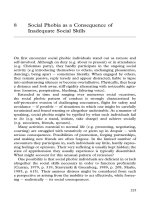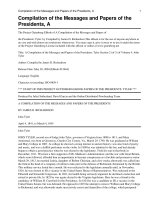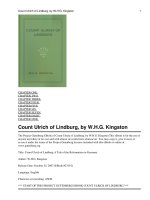Reading Theory as a Microcosm of the Four Skills
Bạn đang xem bản rút gọn của tài liệu. Xem và tải ngay bản đầy đủ của tài liệu tại đây (75.05 KB, 5 trang )
Reading Theory as a Microcosm of the
Four Skills
Ciarán P. McCarthy
Introduction
In the first section of this paper we shall look at how helpful it is to treat, at a theoretical
level, the four language skills separately from one another. In the second section, we shall
imagine, and briefly describe, a small group of L2 learners in a specific classroom context
giving a discursive commentary on how we could set about focusing on the development of
the group's proficiency in reading skills.
Treating the Four Language Skills Separately from One
Another
There is a growing realisation among EFL teachers that the overt processes involved in
language - the four skills of reading, writing, listening and speaking - which have been, in
the past, "treated somewhat in isolation, in fact have so much in common with each other,
that it makes much more sense to treat them holistically", (Wray & Medwell 1991:3). It has
been noted that the links between reading and writing, for example, have been emphasised
to such an extent that it is now normal to see them referred to as "literacy" (ibid.:3).
Similarly, the term "oracy" is commonly used to denote the skills of speaking and listening.
This is no doubt true, even unavoidable, in the practical classroom situation. However, I
would argue that to look at the four skills individually, in order to look for parallels
between the processes is in theoretical terms, far more useful for those who strive to learn
from these theories and use them in a constructive way. Thus, the sum of the parts may be
greater, and more practically helpful, than the whole.
Each of the "four skills" is itself composed of component sub-skills. Grabe (1992:50-3)
notes six in particular in the case of reading. These are:
1. the perceptual automatic recognition skill;
2. linguistic skills;
3. knowledge and skills of discourse structure and organisation;
4. knowledge of the world;
5. synthetic and critical evaluation skills;
6. metalinguistic knowledge and skills.
It is arguable that these sub-skills are, to a greater or lesser extent, also sub-skills of
writing, speaking and listening. This suggests that basic strategies used are similar, if not
exactly the same, in each of the four skills. However, since the four modalities impose
different constraints, at many different levels, on each occasion that they are called upon,
they encourage a unique emphasis on particular combinations of strategies on each
occasion.
In reading, the notions of "bottom-up" and "top-down" processing, (also known as
"outside-in" and "inside-out" processing), are not without their problems. Consider this
sentence (Wray & Medwell 1991: 98) "iF yuo aer a fluet reodur yuo wll hve on pRblme
reOdng ths sNtnce". A purely bottom up strategy, which is essentially a code-cracking
activity, simply cannot account for the comprehension of this sentence. Top-down
strategies must come into play in order that the reader may find "meaning" in these
symbols.
There is a clear parallel here with listening skills. An analogous situation for EFL students
who have only ever heard standard R.P. English spoken, would be when they find
themselves listening to a speaker from inner-city Dublin; indeed, this is a difficult task for
many native English speakers; however, meaning may still be found by both groups. It is
normal for language learners to report that they do not catch every word spoken, but that
they, nonetheless, manage to understand the meaning of the sentence. Conversely, it is also
common that the language learners report that they "understand" every word, but can not
grasp the meaning of the sentence.
Stanovich (1980:36) "questioned the hypothesis-testing models" and rejected them
"because they require[d] implausible assumptions about the relative speeds of the processes
involved". Oakhill & Garnham (1988) assert that while good readers, and, by extension
good listeners, may indeed "have greater contextual awareness, they do not, in fact, need to
use it" and Samuels and Kamil (1988: 32) sum this up by saying that "if a skilled reader
can generate predictions, the amount of time necessary to generate a prediction may be
greater than the amount of time the skilled reader needs to simply recognise the words". So,
a total reliance on top-down processing, while initially attractive, may later lead to some
practical and theoretical conclusions that are less than satisfactory; for example, that the
language learner does not need to develop much conscious knowledge of the features of
written language, because the clause, or even the sentence, would be the most significant
linguistic units, rather than the word. This is particularly problematic in reading theory, as
L1 studies in phonological awareness, by Goswami (1994) and others, have clearly linked
early ability to segment words into their constituent phonemes with later reading
proficiency.
Stanovich's (1980) interactive-compensatory model, while not universally accepted, seems
to account for the major problems encountered by purely top-down or bottom-up
approaches to comprehension, because "process[es] at any level can compensate for
deficiencies at any other level" (ibid.:36). So, it seems that comprehension, of written and
spoken discourse, relies on a symbiosis of top-down and bottom-up strategies. Thus, the
perceptual-automatic recognition skill noted by Grabe (1992) above seems psychologically
real and theoretically plausible, both in terms of Stanovich's model, and of Underwood's
(1982) assertion that "attention can only be diverted to higher-level activities, such as
comprehension, when lower-level activities have become skilled through practice".
"Though recent findings... [by Danks & End (1985) and Lund (1991)] on language
processing... are still tentative, they suggest that basic strategies focusing on the most
important words in a text for example, and activating background schemata are the same in
listening and reading... However, since the two modalities impose different processing
constraints, they encourage the emphasis of different strategies" (Strodt-Lopez: 1996:35-6).
Thus, listeners tend to rely more on top-down processing, from "background knowledge to
the particulars", while readers tend more towards bottom-up strategies, from "the
particulars of the text to background knowledge" (ibid.:35-6).
I believe that in recent years teachers and materials designers have concentrated mainly on
developing the top-down skills for both reading and listening (See Paran: 1996). This
seems to be the case because, while justifiable in theories of L1 skills, they have failed, to
some extent, to recognise that the situation is somewhat different for L2 learners, as they
have to "compensate for the lack of good linguistic skills" and for "the lack of well-
developed automatised skills" (ibid.:29). Similarly, it is also true, to some extent, that there
has been a lack of bottom-up support for the production skills, writing and speaking,
because in recent years, with the advent of communicative language teaching, there has
been an unnecessarily strong, though perhaps not surprising, emphasis by teachers and
materials designers on communication at the expense of accuracy, perhaps due to
misconceptions about what is involved in the communicative approach (See Thompson:
1996).
By looking at any one of the skills, reading in this case, we can see a microcosm of all the
skills. We have noted how some of the more important sub-skills of reading are present in
each of the other three skills. We have seen how the only difference is in their emphasis. It
is my belief that in giving the L2 student both as much input and practice as they can
reasonably manage, and a strong metalinguistic awareness, we, as teachers give the student
the tools to learn a language proficiently. It is in equipping the student with both
declarative knowledge, as well as the procedural knowledge, that they not only listen to the
music, but also appreciate its subtle intricacies.
A Small Group of L2 Learners in a Specific Classroom
Context
In this section of the paper, we will consider some practical ways of aiding a particular
group of students, in becoming more proficient readers. This imaginary group consists of
about ten or so European students, of varied nationalities, in their early to mid-twenties. Let
us say that they are of upper-intermediate standard. They are in Ireland on an intensive four
week course; this course consists of four hours tuition daily, and two two-hour workshops
each week. On the other days, there is an extensive, and carefully structured, social and
cultural programme, which they are free to, and do, participate in. This group will be
familiar to many EFL teachers as they are the backbone of many schools in Ireland and
Britain.
One of the most important initial tasks for any teacher is the task of knowing his clients.
The notion of needs analysis is absolutely central. Even with as few details as we have
outlined above, there are certain things that we can assume about this group. First, given
their age group, it is reasonable to assume that many of them will be students; their needs
in English will most predominantly lie in the area of reading. University systems in Europe,
unfortunately, are dominated by the grammar-translation method of language teaching,
where, as often as not, English is only taught as a means to accessing literature, be it
classical, technical or otherwise. Any of the group that actually work, will almost certainly
be trying to improve their English, as a means of improving their job prospects or job
performance; their needs will be much broader, but, nonetheless, the skills in written
language are likely to be of most concern to them, as the written form is more formally
bound than the spoken form.
Second, given the age group of our clients, they are almost certainly attending the course of
their own accord. Had they not been so motivated, they could have spent two weeks lying
on a beach somewhere sunny, drinking piña coladas, and not using their brains. It is also
worth noting that the clients have opted for intensive courses, over and above the already
taxing four hours a day tuition.
Third, the group is European. This means that they will all be literate; in Europe, so
commonplace is literacy, in fact, that the students will probably have no thoughts on the
subject beyond the idea that everybody is able to read and write. In terms of their English,
being of upper-intermediate level, their skills in English language literacy are probably
quite proficient in certain ways. This does not mean, however, that they are infallible. In
other ways their L2 capabilities are severely restricted.
While the clients' individual learning styles and preferences, their past experiences in
learning language, their linguistic aptitudes, their personalities, perhaps even their views on
life, are probably all quite different, they now find themselves on a (reasonably) level
playing field, culturally, linguistically and in many other ways too. It is this that the teacher
must take advantage of.
All of the group will experience problems with reading, though it is probably true that they
will have had, in some cases, several years tuition, and practice, in reading English. It is for
the teacher to facilitate the strategies necessary for each client to solve his or her own
problems. In approaching a text on an unknown topic with a class, it is often extremely
beneficial to make additions to the text: adding pictures, a title, or perhaps even a short
summary at the beginning. This permits, and even forces, the individuals to build up some
hypothesis or schema, of what the text is likely to consist of. This aids in top-down
processing. On the other hand, we also need to encourage bottom-up processing, and on
occasions, this is may be achieved by pre-reading exercises; for example, a short
brainstorming session by the class, after reading the short summary suggested above, can
often yield a whole whiteboard of material, without any intervention by the teacher. In this
way the "collective consciousness" of the class may be tapped and focused.
Study aids are another useful aid to comprehension facilitation. Activities such as note-
taking, underlining, summary writing and so on, can all help the student to reinforce what
they have learned. However, they play a very helpful dual role: that of comprehension
fostering and comprehension monitoring simultaneously.
Often, it can be helpful for the teacher to teach metacognitive strategies overtly, if not
obviously. A common method of doing this in EFL is the "teacher think-aloud" method. A
simple idea, where the teacher, or better still, the student, simply solves the problem at
hand by going through it mentally, step by step, but voicing these steps all along.
An extension of this is the notion of reciprocal teaching and has been in the communicative
classroom for many years, and has proven itself to be an extremely effective way of
fostering the strategies of questioning, clarifying, summarising and predicting; this too is
both comprehension fostering and monitoring, and is particularly good at fostering a
"collective consciousness". The hallmark of this form of instruction is the lack of passive
inattention, that often accompanies reading. Here the students take turns being the
"teacher" being interactive with his or her students. For example, a number of students
read some short passages aloud, and then the "teacher" asks questions, and leads a
discussion, on the text. All the students are expected to "chip-in" whenever they can. At
upper-intermediate level this can get quite noisy. The "teacher" asks for clarifications on
any of the points raised and finally, the "teacher" summarises the section of the text, and
makes predictions about what is likely to occur in the following sections. Reciprocal
teaching is not only very effective, but it is also very popular with the students, too.
Conclusion
Why does it work so well? There are four main ideas behind it - scaffolding and then
learner autonomy, which, surprisingly, are not actually at odds with each other, but rather
complimentary; active involvement and not passive inattention, and feedback. It is in
becoming acquainted with these ideas, consciously and sub-consciously, in declarative and
procedural terms, that the learners in our imaginary group may flourish.
With these skills, they may recreate this experience, even when reading alone; it is only by
doing this that they may develop their proficiency in the skill of reading. In this very
simple classroom procedure we can see some of the theory outlined in Section One of this
paper put into practice, though given the space constraints of such a short paper, it is hard
to do any justice to the notion that the development of a group's proficiency in any one skill
is closely linked to the development of the strategies and sub-skills embodied in all of the
four skills.









